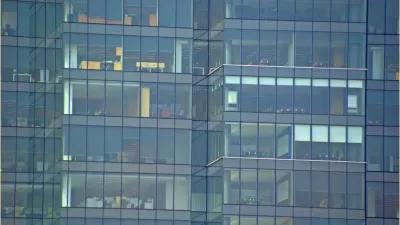Workers who moved away from their jobs during the pandemic are adjusting to longer commutes as employers start asking them to return to the office.

While the pandemic allowed many Americans to relocate while they worked from home and eliminate their commutes altogether, the halting return to the office, at least part-time, has created "a new class of supercommuters." Sarah Holder describes the workers who, after 'untethering' themselves from cities and job centers, now find themselves having to make the extra-long trek to work at least a few times a month.
Defined by a 90-minute one-way trip to work, supercommuting grew by 45 percent between 2000 and 2019 as rising housing costs and exurban sprawl have driven more people farther away from their jobs. According to Chris Salviati, senior housing economist at Apartment List, "There might actually be a lot of folks ending up in situations where now—because they’re not commuting every day—they’re willing to endure a longer commute." Some are taking to the air, with commercial commuter air travel services like Surf Air seeing sharp increases in traffic. The airline, which specializes in flights between Lake Tahoe and the San Francisco Bay Area, has seen a 33 percent monthly rise in flights.
For some, the new arrangement provides an opportunity to move in with long-distance partners, buy a home, or spend time with family—priorities employers will likely have to weigh as they develop the hybrid work models of the future.
FULL STORY: The Remote Work Revolution Spawns a New Class of Supercommuters

Study: Maui’s Plan to Convert Vacation Rentals to Long-Term Housing Could Cause Nearly $1 Billion Economic Loss
The plan would reduce visitor accommodation by 25,% resulting in 1,900 jobs lost.

North Texas Transit Leaders Tout Benefits of TOD for Growing Region
At a summit focused on transit-oriented development, policymakers discussed how North Texas’ expanded light rail system can serve as a tool for economic growth.

Using Old Oil and Gas Wells for Green Energy Storage
Penn State researchers have found that repurposing abandoned oil and gas wells for geothermal-assisted compressed-air energy storage can boost efficiency, reduce environmental risks, and support clean energy and job transitions.

From Blight to Benefit: Early Results From California’s Equitable Cleanup Program
The Equitable Community Revitalization Grant (ECRG) program is reshaping brownfield redevelopment by prioritizing projects in low-income and environmental justice communities, emphasizing equity, transparency, and community benefits.

Planting Relief: Tackling Las Vegas Heat One Tree at a Time
Nevada Plants, a Las Vegas-based nonprofit, is combating the city’s extreme urban heat by giving away trees to residents in underserved neighborhoods, promoting shade, sustainability, and community health.

How Madison’s Tree Planting Efforts Are Growing a Healthier Community
Madison’s annual tree planting initiative is enhancing environmental resilience, public health, and community livability by adding 1,400 carefully selected trees citywide, with strong community and institutional support for urban forestry.
Urban Design for Planners 1: Software Tools
This six-course series explores essential urban design concepts using open source software and equips planners with the tools they need to participate fully in the urban design process.
Planning for Universal Design
Learn the tools for implementing Universal Design in planning regulations.
Ascent Environmental
Borough of Carlisle
Institute for Housing and Urban Development Studies (IHS)
City of Grandview
Harvard GSD Executive Education
Toledo-Lucas County Plan Commissions
Salt Lake City
NYU Wagner Graduate School of Public Service





























